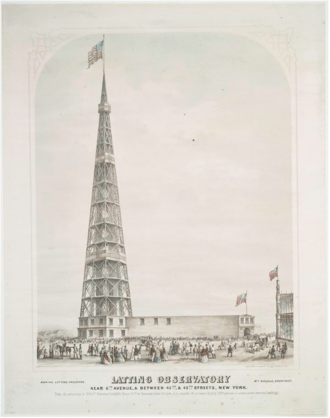Latting Observatory facts for kids
The Latting Observatory was a tall wooden tower built in New York City way back in 1853. It was part of a big event called the Exhibition of the Industry of All Nations, and it stood right next to the New York Crystal Palace.
You could find this amazing tower on 42nd Street, between Fifth Avenue and Sixth Avenue. Today, it would be across from Bryant Park. A man named Waring Latting thought up the idea, and William Naugle designed it.
The observatory was made of wood and had eight sides, strengthened with iron. It was super tall, about 315 feet (96 m) high! That's taller than many modern buildings. It even had three different levels where visitors could go up and use telescopes. From these levels, you could see far away into Queens, Staten Island, and even New Jersey.
For a while, the Latting Observatory was the tallest building in New York City. It was even taller than the spire of Trinity Church, which was 290 feet (88 m) high. The tower's base was a 75-foot (23 m) square, getting narrower towards the top. Up to 1,500 people could be on the tower at one time! Sadly, it burned down in 1856. The Latting Observatory later inspired the famous Eiffel Tower in Paris.
Rising High
When it was built, the Latting Observatory was the tallest building in the United States. Some people even called it "New York's first skyscraper." The bottom part of the building had shops. Above that, there were three viewing platforms at 125 feet (38 m), 225 feet (69 m), and 300 feet (91 m). Visitors could use telescopes there to look at the city and beyond.
The original plans for the observatory included a steam elevator to take people to all three levels. However, this would have been very new technology. At that time, the tallest elevator ever built was only 75 feet (23 m) high. It seems the steam elevators were never actually installed. So, people had to climb winding stairways to reach the top.
When the observatory opened on July 1, 1853, a writer for The New York Times was amazed. He said he "was not prepared for the wonderful panorama" he saw. The view stretched for 40 to 60 miles (60 to 100 km). He felt it was a better view than from London, Paris, or even the Great Pyramid of Giza. He described New York as a "human hive," full of busy people. He also joked that climbing to the top was "fatiguing, but it improves digestion."
The Fire and Fall
After the big fair ended in 1854, a company called Hydeville Marble Works bought the building. A year later, they removed the top 75 feet (23 m) of the tower.
The observatory was destroyed by a fire that started very late at night on August 30, 1856. The fire began in a barrel maker's shop nearby. The flames quickly spread and could be seen for miles around. Many people came to watch the huge fire.
The fire destroyed more than twelve buildings, and several families lost their homes. Luckily, no one was hurt or killed in the incident. The Hydeville Marble Works lost $100,000 worth of goods and buildings. Only $17,500 of that was covered by insurance.
The New York Times called it "one of the most destructive conflagrations" the city had seen in a long time. The total value of the destroyed property was $150,000, with most of that being the tower itself. The newspaper said the tower was an important "landmark" that travelers used to find their way. They also said it would be "greatly missed." However, as a business, the tower was a "stupendous failure." It never made back the $150,000 that was spent to build it.
People watching the fire were worried the tower would fall onto the nearby Crystal Palace. But the observatory burned straight down onto its own base, becoming a "mass of smouldering cinders." Firefighters from Williamsburg and other parts of Brooklyn even crossed the East River by ferry to help put out the blaze.
Lasting Impact
The famous engineer Gustave Eiffel, who designed the Eiffel Tower, said that the idea for an observation tower "came from America." However, he felt his tower in Paris was better than the American one in several ways.
The Latting Observatory was built mainly "for commercial purpose," meaning to make money. It wasn't built with much thought for how beautiful it looked. The Eiffel Tower, built about thirty years later, was designed to be both useful and beautiful.
See also
 In Spanish: Observatorio Latting para niños
In Spanish: Observatorio Latting para niños


